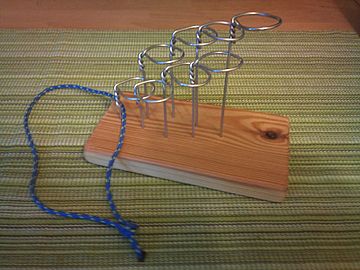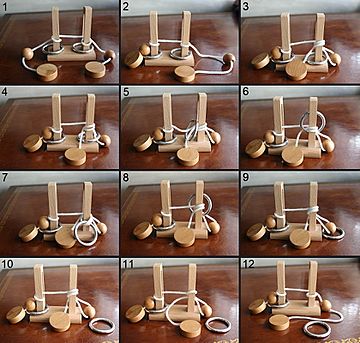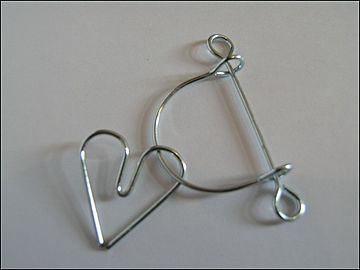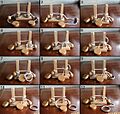Disentanglement puzzle facts for kids
Disentanglement puzzles are a fun type of mechanical puzzle. They are also called entanglement puzzles or wire puzzles. The main goal is to take one part of the puzzle away from another. It's like trying to untangle a knot!
These puzzles often use wire, string, or rings. Sometimes, the challenge is to put the pieces back together. This can be even harder than taking them apart! There are many different kinds of disentanglement puzzles.
Contents
Puzzles with Wires and Strings
Wire-and-string puzzles usually have:
- A piece of string, ribbon, or similar material. This string might form a closed loop. Or it might have balls or other items fixed to its ends.
- One or more pieces of stiff wire.
- Sometimes, extra pieces like wooden balls. The string might be threaded through these.
There are a few types of wire-and-string puzzles:
- Puzzles with a closed string loop: Here, the string forms a circle. Your job is usually to free the string from the wire. The Baguenaudier puzzle is a famous example.
- Puzzles with loose string ends: The string is not a closed loop. Its ends often have balls or cubes. These stop the string from slipping out easily. You usually need to separate the string from the wire. Sometimes, you just move a ring or ball along the string.
- Puzzles with a fixed string: In these puzzles, the string is attached to the wire. You don't try to remove the string. Instead, you might move a ring or ball from one end of the string to the other.
One very tricky puzzle was made by R. Boomhower in 1966. It has been changed into many designs. These include puzzles shaped like a paddle or with vertical beams. Some versions have the string pass through a slot once or twice. This puzzle is known by names like the Boomhower puzzle or Wit's End puzzle. The "Mini Rope Bridge puzzle" is another version.
Wire Puzzles
Wire puzzles are also called nail puzzles. They are made of two or more pieces of stiff wire. These pieces are tangled together. The wire pieces might be closed loops or have complex shapes.
To solve them, you must separate the pieces. You cannot bend or cut the wires. Early wire puzzles were often made from bent carpenter's nails or horseshoes.
Plate-and-Ring Puzzles
A plate-and-ring puzzle usually has three parts:
- A plate with many holes or dents.
- A closed ring or similar item.
Both the plate and the ring are usually made of metal. The goal is to free the ring from the plate.
Puzzles with No Solution
Some puzzles look simple but are actually impossible to solve! One example is the "Notorious Figure Eight Puzzle." It is sometimes sold with hints about how hard it is. A "solution" might be given, but it's often vague and impossible to follow. This is because the puzzle truly cannot be solved.
Images for kids
See also
 In Spanish: Rompecabezas topológico para niños
In Spanish: Rompecabezas topológico para niños









